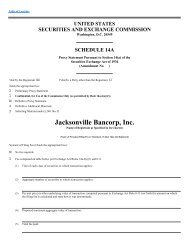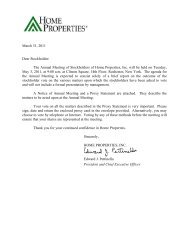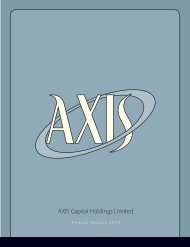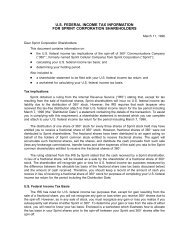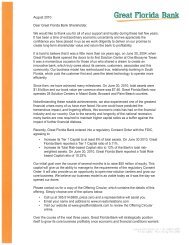pab bankshares, inc. - SNL Financial
pab bankshares, inc. - SNL Financial
pab bankshares, inc. - SNL Financial
You also want an ePaper? Increase the reach of your titles
YUMPU automatically turns print PDFs into web optimized ePapers that Google loves.
NOTES TO CONSOLIDATED FINANCIAL STATEMENTS<br />
NOTE 1.<br />
SUMMARY OF SIGNIFICANT ACCOUNTING POLICIES (Continued)<br />
Deferred <strong>inc</strong>ome tax expense results from changes in deferred tax assets and liabilities between periods. Deferred tax<br />
assets are recognized if it is more likely than not, based on the technical merits, that the tax position will be realized or<br />
sustained upon examination. The term more likely than not means a likelihood of more than 50 percent; the terms<br />
examined and upon examination also <strong>inc</strong>lude resolution of the related appeals or litigation processes, if any. A tax<br />
position that meets the more-likely-than-not recognition threshold is initially and subsequently measured as the largest<br />
amount of tax benefit that has a greater than 50 percent likelihood of being realized upon settlement with a taxing authority<br />
that has full knowledge of all relevant information. The determination of whether or not a tax position has met the morelikely-than-<br />
not recognition threshold considers the facts, circumstances, and information available at the reporting date<br />
and is subject to management’s judgment. Deferred tax assets may be reduced by deferred tax liabilities and a valuation<br />
allowance if, based on the weight of evidence available, it is more likely than not that some portion or all of a deferred tax<br />
asset will not be realized. Accordingly, a valuation allowance has been established in the amount of $11,403,899 against<br />
such benefits at December 31, 2009, compared to $267,960 at December 31, 2008.<br />
Stock Based Compensation Plans<br />
Stock compensation accounting guidance (FASB ASC 718, Compensation - Stock Compensation) requires that the<br />
compensation cost relating to share-based payment transactions be recognized in financial statements. That cost will be<br />
measured based on the grant date fair value of the equity or liability instruments issued. The stock compensation<br />
accounting guidance covers a wide range of share-based compensation arrangements <strong>inc</strong>luding stock options, restricted<br />
share plans, performance-based awards, share appreciation rights, and employee share purchase plans.<br />
The stock compensation accounting guidance requires that compensation cost for all stock awards be calculated and<br />
recognized over the employees’ service period, generally defined as the vesting period. For awards with graded-vesting,<br />
compensation cost is recognized on a straight-line basis over the requisite service period for the entire award. A Black-<br />
Scholes model is used to estimate the fair value of stock options, while the market price of the Company’s common stock<br />
at the date of grant is used for restricted stock awards and stock grants.<br />
Earnings Per Share<br />
Basic earnings per share represents <strong>inc</strong>ome available to common stockholders divided by the weighted-average number of<br />
common shares outstanding during the period. Diluted earnings per share reflects additional potential common shares that<br />
would have been outstanding if dilutive potential common shares had been issued, as well as any adjustment to <strong>inc</strong>ome<br />
that would result from the assumed issuance. Potential common shares that may be issued by the Corporation relate solely<br />
to outstanding stock options, and are determined using the treasury stock method.<br />
Comprehensive Income (Loss)<br />
Accounting pr<strong>inc</strong>iples generally require that recognized revenue, expenses, gains and losses be <strong>inc</strong>luded in net <strong>inc</strong>ome.<br />
Although certain changes in assets and liabilities, such as unrealized gains and losses on available for sale securities and<br />
cash flow hedge derivative instruments, are reported as a separate component of the equity section of the balance sheet,<br />
such items, along with net <strong>inc</strong>ome, are components of comprehensive <strong>inc</strong>ome.<br />
Transfers of <strong>Financial</strong> Assets<br />
Transfers of financial assets are accounted for as sales, when control over the assets has been surrendered. Control over<br />
transferred assets is deemed to be surrendered when (1) the assets have been isolated from the Corporation - put<br />
presumptively beyond the reach of the transferor and its creditors, even in bankruptcy or other receivership, (2) the<br />
transferee obtains the right (free of conditions that constrain it from taking advantage of that right) to pledge or exchange<br />
the transferred assets, and (3) the Corporation does not maintain effective control over the transferred assets through an<br />
agreement to repurchase them before their maturity or the ability to unilaterally cause the holder to return specific assets.<br />
69





